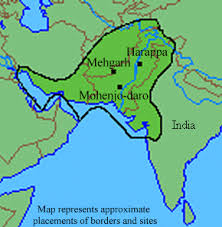|

Man Was Enduring the
Dentist's Drill
9,000 Years Ago Near
Indus Valley Civilization
New York Times:
By KYLE JARRARD: International Herald Tribune: Published: April 5, 2006
PARIS, April 5: Man's first known trip to the dentist
occurred as early as 9,000 years ago, when at least 9 people living in a
Neolithic village in Pakistan had holes drilled into their molars and
survived the procedure.
The findings, to be reported Thursday in the scientific review Nature, push
back the dawn of dentistry by 4,000 years to around 7000 B.C. The drilled
molars come from a sample of 300 individuals buried in graves at the
Mehrgarh site in western Pakistan, believed to be the oldest Stone Age
complex in the Indus River valley.
"This is certainly the first case of drilling a person's teeth," said David
Frayer, professor of anthropology at the University of Kansas and the lead
author of the report. "But even more significant, this practice lasted some
1,500 years and was a tradition at this site. It wasn't just a sporadic
event."
The earliest previously known evidence of dental work done in vivo was a
drilled molar found in a Neolithic graveyard in Denmark dating from about
3000 B.C.
All 9 of the Mehrgarh dental patients were adults ? 4 females, 2 males, and
3 individuals of unknown gender ? and ranged in age from about 20 to over
40. Most of the drilling was done on the chewing surfaces of their molars,
in both the upper and lower jaws, probably using a flint point attached to a
bow that made a high-speed drill, the researchers say. Concentric ridges
carved by the drilling device were found inside the holes.
The drilling may have been done to relieve the pain and damage of tooth rot,
but only 4 of the total of 11 teeth showed signs of decay associated with
the holes. The scientists say it is clear that the holes were not made for
aesthetic reasons, given their position deep in the mouth and on the
erosion-prone surface of the teeth.
While there is no evidence of fillings, the researchers believe something
was used to plug the holes because some of them were bored deep into the
teeth. What that filler substance was is unknown. The holes ranged in depth
from a shallow half-a-millimeter to 3.5 millimeters, deep enough to pierce
the enamel and enter the sensitive dentin. |

INDUS VALLEY CIVILIZATON - THE OLDEST IN THE KNOWNE
HISTORY OF EARTH
Dental health was poor at Mehrgarh, though the problems were less often
tooth decay than brutal wear and tear. Roberto Macchiarelli, professor of
paleoanthropology at the University of Poitiers, France, and the report's
lead anthropological researcher, attributed the bad teeth to the Neolithic
diet, which included newly domesticated wheat and barley.
"A lot of abrasive mineral material was introduced when grains were ground
on a stone," Professor Macchiarelli said, "and as these people moved to a
grain diet, their teeth wore down, dentin was exposed, and the risk of
infection rose."
The Mehrgarh complex, occupied for 4,000 years, sits beside the Bolan River
in Baluchistan, on a plain that was repeatedly buried in alluvial deposits
that not only destroyed mud-brick buildings but crushed many skeletons in
the graveyard. The excavation of 300 individuals was begun by a French team
in the 1980's; international groups followed until 2001, when it became too
dangerous to work in Baluchistan.
None of the individuals with drilled teeth appears to have come from a
special tomb or sanctuary, indicating that the oral health care they
received was available to anyone in the society.
Professor Frayer said that, given the position of the holes and the angles
of the drilling, "we're pretty sure these were not self-induced." That the
patients lived to tell the tale of their dental visit is proved, he says, by
subsequent wearing down of their teeth and by deliberate smoothing and
widening of the holes later on.
The dentists may have been highly skilled artisans at Mehrgarh, where beads
of imported lapis lazuli, turquoise, and carnelian were found drilled with
holes even smaller than the ones in the nine individuals. Discovered among
the beads were finely tipped drill heads.
"The drilling of teeth is very rare in the anthropological record," said
Professor Macchiarelli, noting that work similar to that done at Mehrgarh
does not recur until much later, among the Anasazi Indians of the southwest
United States around 1100 A.D., and in Europe around 1500 A.D.
[The 1,500-year-long tradition of drill work at Mehrgarh appears not to have
been passed down to later cultures. There is no evidence that the
Chalcolithic, or Copper Age, people who next lived there ever visited the
dentist. Why the practice came to a halt is not known.
|

